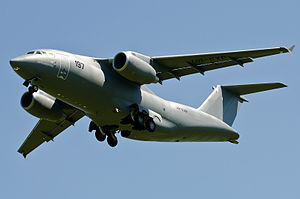Antonov An-178
| An-178 | |
|---|---|
 |
|
| Role | Military transport aircraft |
| National origin | Ukraine |
| Design group | Antonov |
| Built by | Antonov Serial Production Plant |
| First flight | 7 May 2015 |
| Status | In production |
| Number built | 1 (2015) |
| Program cost | US$ 150-200 million |
| Unit cost |
US$ 40-70 million
|
| Developed from | Antonov An-158 |
The Antonov An-178 (Ukrainian: Антонов Ан-178) is a short-range medium-airlift military transport aircraft designed by the Ukrainian Antonov company and based on the Antonov An-158 (An-148-200). It was announced on 5 February 2010, rolled out on 16 April 2015 and the first flight was on 7 May 2015.
The An-178 is proposed to replace outdated aircraft like the Antonov An-12, Antonov An-26 and Antonov An-32. The aircraft will have avionics suite similar to the An-148, and will use Progress D-436-148FM engines.
The An-178 is a potential competitor for the Alenia C-27J Spartan from Italy, EADS CASA C-295 from Spain, Lockheed Martin C-130J from the United States, Embraer KC-390 from Brazil and the Ilyushin Il-214 from the Russian Federation. The company plans to build more than 200 of the aircraft.
On 18 December 2015, Antonov and Тaqnia Aeronautics signed a Memorandum to deliver 30 An−178s to the Royal Saudi Air Force. Taqnia's President, Ali Mohammed Al−Ghamdi, noted that the An-178 had been selected because "its price and low operational costs are important advantages in comparison with other airplanes of this class".
An-178 is a high-wing transport aircraft with moderately swept wing, winglets and a T-tail. The airframe is made of aluminium alloys and composite materials. The fuselage is semi-monocoque with a circular cross-section. The retractable landing gear consists of two main wheel bogies and a single nose wheel. The flight control system is dual duplex fly-by-wire system, consisting of two parts: FCS-A and FCS-B, each of which is responsible for two control channels. The flight control surfaces include ailerons near the wing tips, four control spoilers, six lift-dump/speed-brake spoilers, rudder and elevators, with an emergency mechanical cable back-up system. The powerplant consists of two Progress D-436-148FM turbofan engines, mounted on pylons under the wings and an auxiliary power unit. It can shift 18 tonnes over 1,000 km, or 10 tonnes over 4,000 km.
...
Wikipedia
